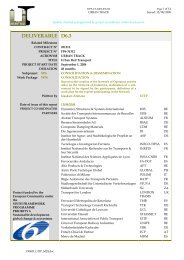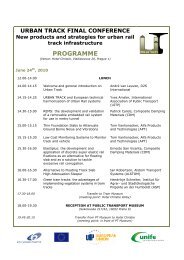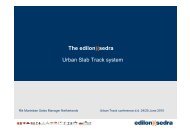DELIVERABLE 2.8 - urban track
DELIVERABLE 2.8 - urban track
DELIVERABLE 2.8 - urban track
You also want an ePaper? Increase the reach of your titles
YUMPU automatically turns print PDFs into web optimized ePapers that Google loves.
D0208_STIB_M24.doc<br />
TIP5-CT-2006-031312 Page 30 of 44<br />
URBAN TRACK Issued: August 13, 2008<br />
Quality checked and approved by project co-ordinator André Van Leuven<br />
Either huge force amplitudes or long areas with geometry other than the prescribed one are obtained.<br />
Especially, for constant cant gradients the following results are estimated:<br />
Sharp kinks at the ends of constant cant gradients are impossible for continuous welded rails.<br />
There are always rounded connections, which elongate the constant cant gradient.<br />
Steep constant cant gradients have either a great length of the rounded connections (>> 10 m) or high<br />
stress in the railroad <strong>track</strong>.<br />
Therefore, rapid decay of the <strong>track</strong> alignment geometry starting from the kinks of the straight ramp.<br />
Steep and short constant cant gradients are never straight but everywhere bended.<br />
Curvature and cant in the rounded connections are no longer proportional.<br />
The Viennese Curve:<br />
The Viennese transition curve and cant gradient and its similar products have a very smooth connection<br />
to the neighbouring elements and are based on a high order function. They all fulfil the following<br />
requirements:<br />
Acceleration and jerk are continuous and smooth, not only in the <strong>track</strong> centre line, but also<br />
everywhere within the guided vehicle.<br />
In the cant gradient, the continuous welded rails are not forced to yield the prescribed geometry. The<br />
shape is kept with minimal forces obeying bending theory.<br />
Track alignment design is performed for a certain height (the medium height of centres of mass of the<br />
vehicles), not for the singular <strong>track</strong> centre line. Therefore, guiding forces are kept small.<br />
The Viennese curve has the simplest mathematical description for the fulfilment of all these demands:<br />
Low forces (external from the vehicle and internal from the <strong>track</strong>).<br />
Less maintenance (high potential for durability).<br />
The following graphs show the basic functions and their derivates in comparison with the well-known<br />
transition curves presently used.








